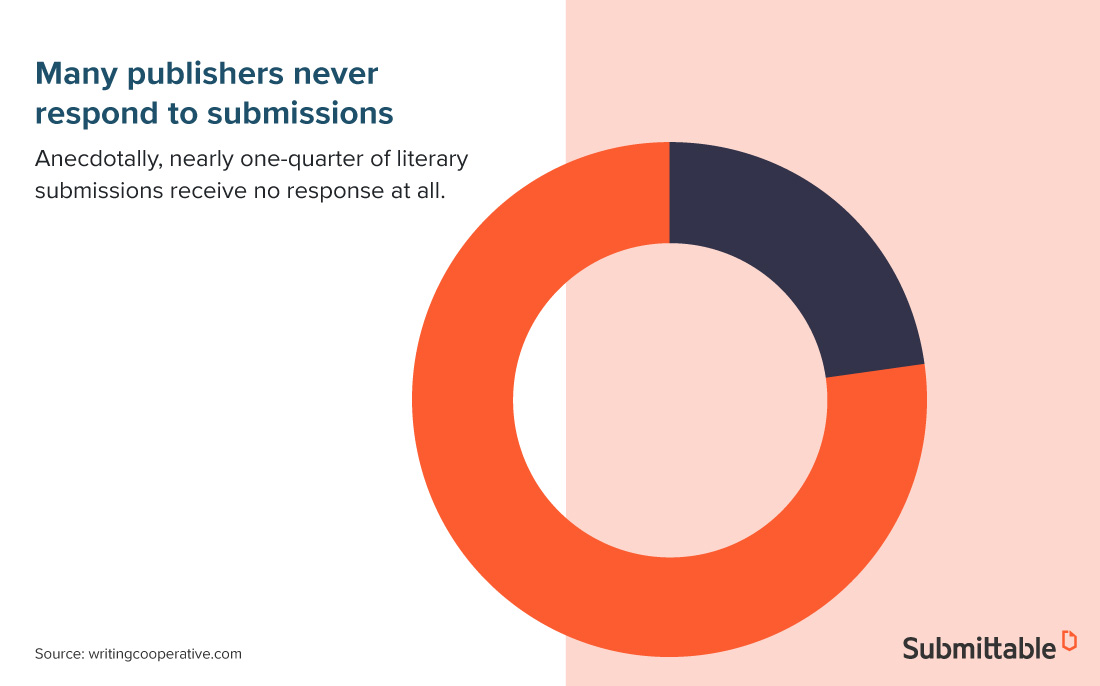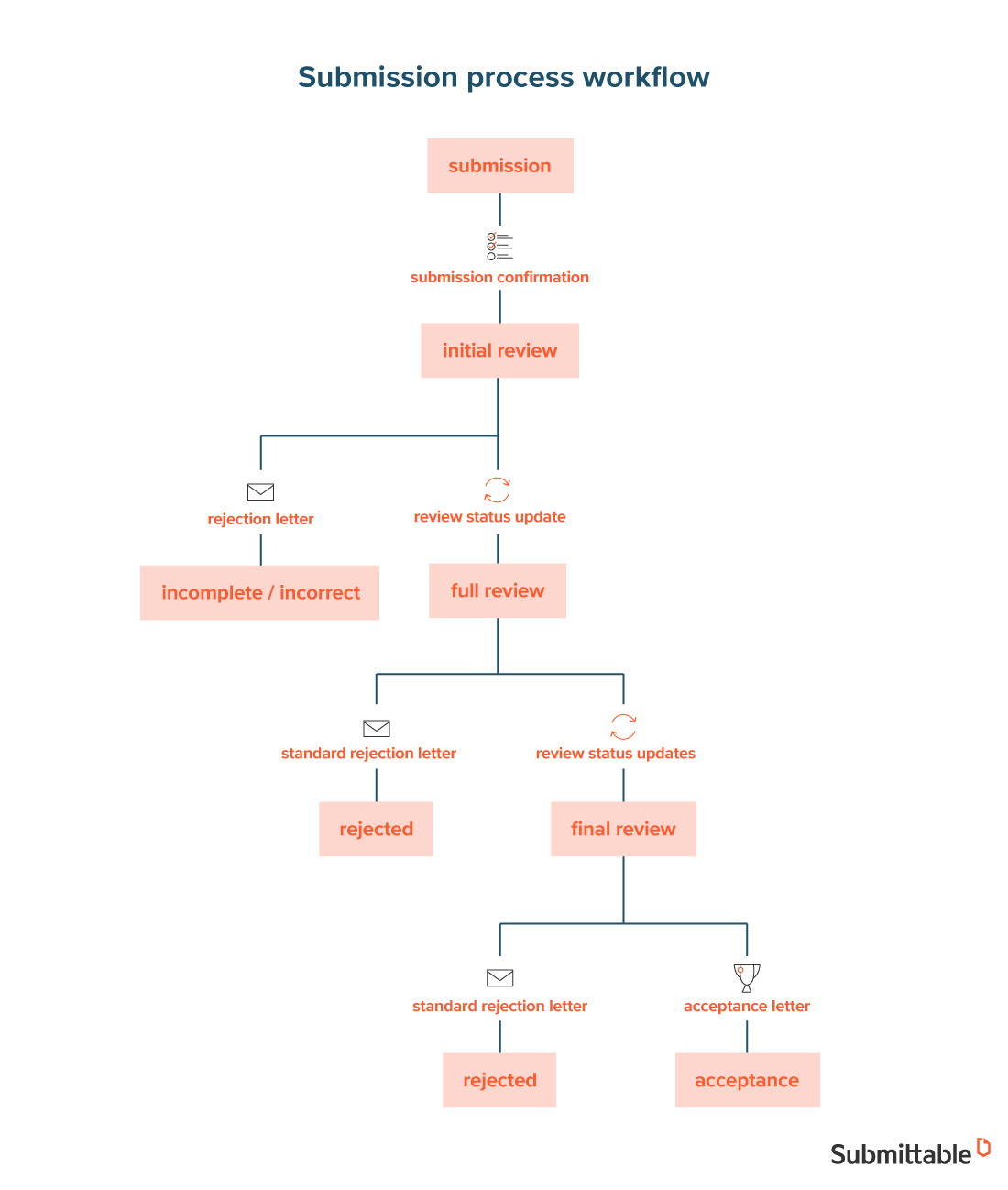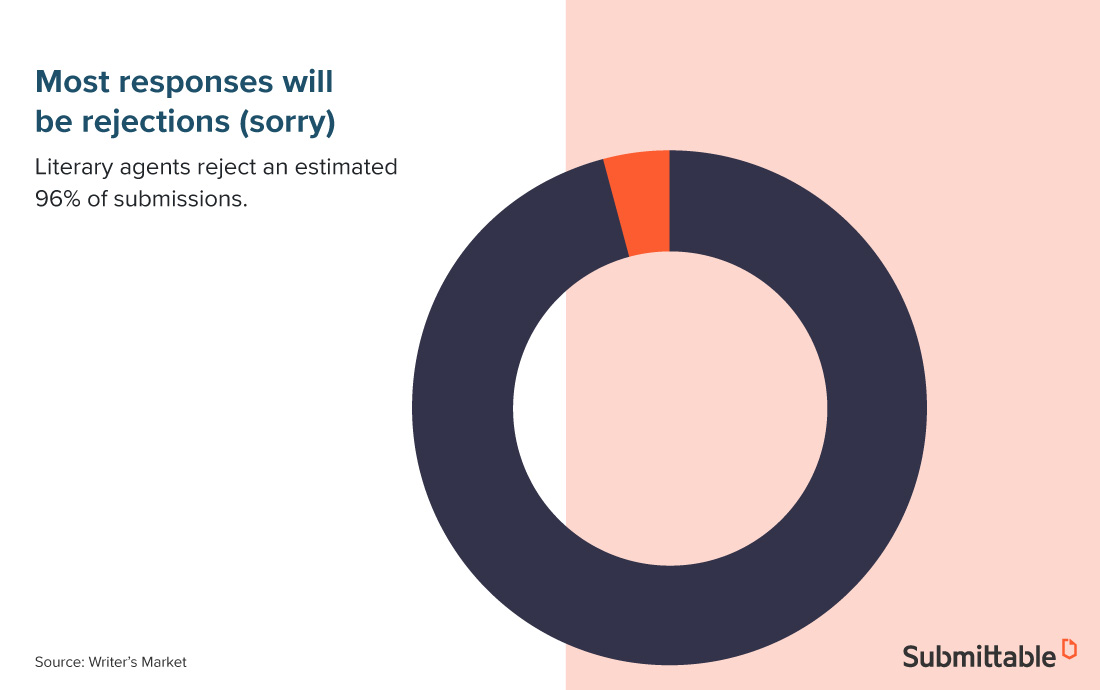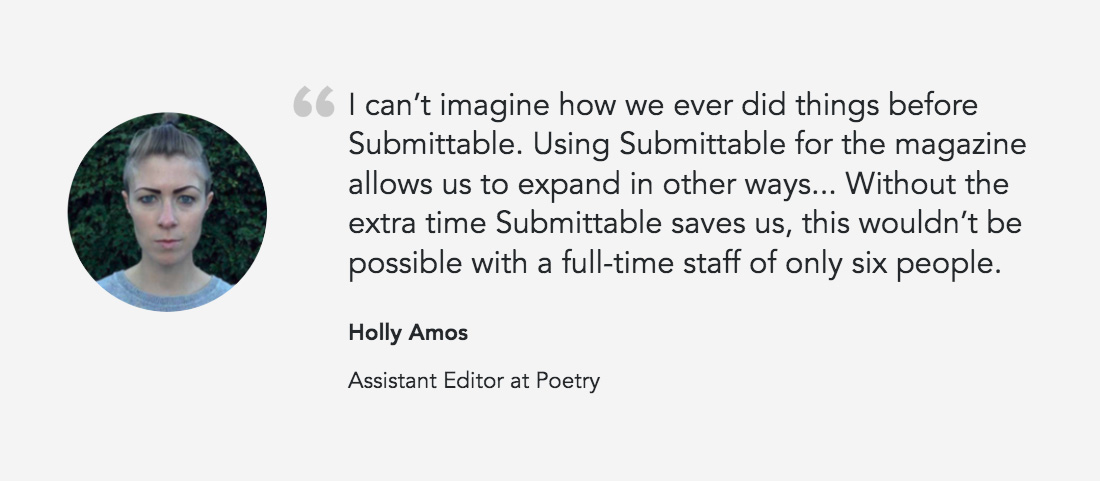Silence is deafening.
For someone who submits work to literary agents and journals, the most disappointing response is almost always no response. Yet, many publishers are still leaving submitters in the lurch.
This is the worst kind of rejection.
It’s the kind that leaves you with just enough optimism that your heart flutters every few weeks when you remember that they haven’t said no yet.
But then you quickly realize that, even if they haven’t said no, they’ve still pretty much said no.

One of the most important parts of your literary submission strategy—and the submission experience—is communication.
Keep in mind that the publisher and submitter relationship is symbiotic—both parties have a lot to gain and a lot to lose based on this relationship. If someone has taken the time to submit their work, it’s important to treat them with respect, regardless of whether it’s a fit.
The submission experience matters.
Of course, it’s easy for any publisher or agent to be inundated with submissions that clog up the system and make it seemingly impossible to keep up, let alone communicate with each individual who sends in their work.
But with the right combination of communication strategy and submission management technology, that pile of manuscripts can be transformed with a process that runs like a well-oiled machine and quickly surfaces the best work and strengthens the relationship with your submitters.
Literary Communications: Building a Solid Strategy & Workflow
Delivering the right communication throughout the submission process is as much about timing and expectations as it is about the words that you use when sending an acceptance or rejection letter.
So, what should your communication flow actually look like?
We can break this down into several steps:
- Confirmation of the receipt of each submission
- Updates as the submissions roll through your review process
- Rejection letters for submissions that are incomplete or incorrect
- Rejection letters for submissions that do not fit the project need or direction
- Personalized rejection letters for work that has been reviewed and considered, but not accepted
- Acceptance letters for work that you wish to move forward with
- Notifications if submissions remain in the same review stage for a period of time
These 7 types of communications make the process run more smoothly—and vastly improve the submission experience.
If we were to map them out into a simple workflow, it might look something like this:

With this framework in mind, let’s look at some of the key components for successful communications—whether you’re sending an acceptance or rejection letter.
6 Tips for Writing Literary Acceptance & Rejection Letters
For every step in the submission communication strategy, you want to be thoughtful about how you notify submitters regarding your decision, what information you include or exclude, and any additional resources that you can provide in order to improve the experience in the future.
Crafting acceptance and rejection letters is just as much about your team—and your time—as it is about the submitter who’s receiving the news.
Having clear and well-executed communications can improve your workflow and impact both the quality and quantity of submissions that you receive in the future.
1. Get to the point
No one likes to be held in suspense (when they’re submitting work!)
Make sure that the language and flow of your communications make your editorial decision clear and apparent, even at an initial glance.
This applies equally for both acceptance and rejection letters.
The last thing that writers want in a rejection letter is a long and confusing message. Likewise, no one likes a buried lede when they’re receiving good news.
Make it obvious right away that the work has been accepted or rejected and then move onto the details of the process, next steps, or any specific feedback that would help the writer on any future submissions.
Moreover, as a publisher or agent, it behooves you to state your decision clearly. Not only will this make writers feel better about receiving either form of news, but it will also save you from follow-up responses, clarification emails, and more.
2. Be precise with your language
If you are notifying a writer that their work has been submitted, they should walk away from this message knowing exactly what it means for them. Will they be receiving subsequent communications? Do they need to take additional steps in order to move to the next step in the editorial process?
Once you’ve made your decision known, it’s time to provide specific details or feedback if possible.
No matter the decision, precision is important for all types of communications.
If the work was rejected based on editorial standards, make that known. If it was rejected because it didn’t contain the necessary documentation or the submission itself was incomplete, that should be part of the message, too.
You’ll also want to let the writer know if you’d like them resubmit based on your feedback.
Precision here is important, so make sure that whatever message you’re conveying, you follow it up with a concrete directive as to what this means for the person on the other end.
3. Avoid fake personalization
Basic personalization of responses, like form letters that use names and titles, is fine. However, it can be tempting to create a form rejection or acceptance letter that feels more personalized, even when it’s not. Avoid doing this.
If the message that you’re sending has not been personalized to reflect a writer’s work specifically, make sure that the boilerplate won’t be misconstrued as a personalized response.
Most writers know the difference between a personalized rejection letter and a standard one. Fake personalization can feel more demeaning than valuable, especially when it’s clear that the intention was for the message to “feel” personal when it’s really not.
Worst case scenario, the false personalization can send the entirely wrong message given the context of the submission.
4. Make constructive comments if possible
In almost no case is it feasible for every response letter to be personalized with feedback.
However it’s usually helpful to provide pointed, constructive feedback whenever possible to guide the writer, give them encouragement, and ideally to improve any future submissions that they make. In many editorial workflows, there is a later round of review where only a handful of works are more closely scrutinized. If it makes sense within your process, this would be a good opportunity to flag those that make it closest to acceptance but are ultimately rejected.
Providing feedback here can help those writers make it “over the hump” on future attempts. This can help improve submission flow in the future.
Aside from an acceptance, this is usually the best kind of rejection letter a writer can receive.
5. Offer resources or insights to help improve the entire experience
Most rejection letters likely won’t be personalized. But that’s okay.
You can still provide value for the writer while also helping to improve the quality of submissions in the future.

You can accomplish this by providing links or documentation to relevant resources that may help writers to better target your specific needs or guidelines in the future.
Consider adding links to your rejection letter for resources like:
- Editorial style guides
- Publishing calendars
- Detailed calls for submission that outline the specific types of work that you’re currently looking to receive
6. Describe the editorial process with as much detail as possible
Especially when sending an acceptance letter, it’s important to detail what the workflow will look like and what the writer should expect in terms of subsequent follow ups or communications. Again, making this clear in your notice of acceptance can save you back-and-forth with writers who may not know what happens next in the flow.
What does acceptance mean, exactly?
Will the work be published immediately? Are you entering into a negotiation phase? Or has the work simply been accepted for a further round of review and consideration?
Don’t leave these details open to misunderstanding.
Detailed & Precise: Crafting a Literary Acceptance Letter
With these general tips in mind, let’s look at the specific language and flow of crafting literary acceptance letters that communicate your intention clearly while also providing all of the pertinent details.
Acceptance letters are probably one of your favorite things to send.
It feels good to deliver good news and you’re probably excited about the work itself. It’s a win-win.
Even so, how, exactly, you want to notify accepted writers warrants consideration.
Here are some sample literary acceptance letters that showcase the tips above.
Example literary acceptance letter #1: Followup request letter
For many publishers and agents, “acceptance” is a tenuous term that really means there’s interest but nothing is set in stone.
As discussed previously, it’s important to make this clear and use precise language about the stage of the work and the overall editorial process.
Example:
Hey Mike,
Thanks for your submission. I really enjoyed your piece and would like to move forward.
At this stage, we are interested in discussing some modifications and beginning the publishing negotiation process. Before any decisions can be made, we’ll need to come to an agreement on final editing, terms, and numbers.
Can we schedule a time to discuss your work in more detail?
There’s good news right up top, but it’s still clear that this is only the first step in the actual process. This kind of acceptance letter has the right balance of encouragement and healthy pragmatism.
Example literary acceptance letter #2: Partial request letter
Somewhere between acceptance and follow-up is the request to review an excerpt. Here, again, precision and detail is important for providing the submitter with a clear understanding of where they stand and what they should expect in the coming days, weeks, or months (hopefully not years!)
Example:
Fiona,
Thank you for submitting your work to TH Publishers.
Could you please submit the first 50 pages in a Word document for our review?
For details on how to prepare and submit your partial manuscript, please review our guidelines here: <link>.
Please understand that this does not mean your work has been accepted for publication. This partial manuscript will still be subject to editorial review by our team and it could take 3-6 month to receive a final decision.
The key here is setting expectations about what happens next that even includes a timeline. Links for relevant guides or resources are also helpful in case the writer has questions or is unfamiliar with the process or specific terminology.
Example literary acceptance letter #3: Outright acceptance
Best case scenario, you decide to accept a submission for publication. This type of letter is obviously more common for journals and magazines than long-form publications, but depending on your submission workflow, it could come in many forms.
For this literary acceptance letter, you want to make clear that the work has been approved.
You also want to let the submitter know if there will be any additional steps like editing that need to take place before the work can be published.
Example:
Dear Mary,
Thank you for your wonderful submission. We are pleased to notify you that we have accepted your work.
We’ll be publishing this piece in an upcoming edition. Here’s what the process will look like:
- From here, our editors will begin the process of finalizing the placement
- We will reach out to you with a contract, a short biography, and relevant social media links
- Within 3-4 weeks, we should confirm the date of publication
- An editor will be in touch to let you know when this work will go to press
I appreciate your patience while we go through our standard editorial process.
Congratulations and thank you again for your submission.
Being the bearer of good news is easy, though, right?
Let’s look at some examples of rejection letters next.
Empathetic, But Straightforward: Crafting Literary Rejection Letters
No one wants to get rejected. And you probably hate rejecting people. But don’t let your empathy create a swirl of confusion or uncertainty. Leading submitters on—or giving them a sense of false hope-—is much worse than a flat rejection.
Yes, you can empathize with the situation and let the writer know that you value them even if their work didn’t meet your standards or needs.
But don’t mince words here.
If the work is being rejected, make it clear and unequivocal. Don’t leave room for misinterpretation.
Here are some examples of rejection letters to help you find just the right tone.
Example literary rejection letter #1: Incomplete or incorrect submission
The most obvious (and maybe most common) form of rejection letter happens when a submitter simply doesn’t supply all of the needed information.
Incomplete and incorrect submissions can gum up your workflow, so it’s important to have a system and process for dealing with them quickly.
Writing a simple notification can communicate this clearly and make it apparent that the submitter missed something. This also leaves the door open for them to clean up their submission and try again.
It’s important to distinguish this type of rejection letter from the standard “no thanks” so submitters have a clear understanding and can resubmit if appropriate. This is important for publishers, too, because it avoids situations where a technical hurdle could cause them to miss out on otherwise great work.
Example:
Dear Mark,
Thank you for your submission to Lit Lit Quarterly. Unfortunately, your submission was incomplete.
This work will not be reviewed by our editorial team. It did not contain all of the information or attached documents that we requested in our submission form.
For more details: <link>
I would invite you to review these submission guidelines closely and consider re-submitting your work if you’re able to provide all of the necessary information.
Please do not respond to this email. Submissions are only accepted, in full, via our standard submission form.
Example literary rejection letter #2: Standard “no thanks”
Many works simply won’t be a fit. Writers should expect that.
So, when crafting a standard rejection letter for submissions that don’t fit your current needs or the publication’s focus, you should have a clear and unequivocal notice. Let writers know that you value their work but it won’t be published, and politely request that they don’t continue to send you the same work.
Example:
Susan,
Thank you for giving us a chance to review your work.
Our editorial team has decided that this is not a fit for us and we will not be moving forward.
I understand this may not be the response you were hoping to receive. I’d like to invite you to review our publishing calendar and consider submitting new work in the future that aligns with our changing editorial needs.
Please see the calendar here: <link>
We’re pleased whenever someone takes the time to submit work for our review and sincerely appreciate you giving us this opportunity.
Thank you again for considering us and best of luck to you.
Admittedly, this one may sting a bit. But, it’s quick and to the point—writers will appreciate the candor and respect.
Example literary rejection letter #3: Personalized rejection
For work that aligned closely with your needs, you may want to provide a personalized note.
This can be helpful for several reasons, including maintaining a healthy relationship with authors that are likely to be accepted in the future, providing some defined feedback, and even possibly inviting the writer to resubmit an updated work.
Example:
Dear Henry,
Thank you for submitting your work for our review.
Unfortunately, we have decided not to move forward with this piece in its current form.
I would like to offer you some further notes from our editorial team:
- Some of the character development felt a bit rushed
- The dialogue could be more powerful
This work did make it to a final round of review and we see its potential. I’d like to invite you to resubmit the work within the next 2 months if you choose to make adjustments based on our feedback.
In either case, you are welcome to submit new work at any time through our submission form.
Thank you again for considering us for publication and best of luck to you.
In this case, you’ve delivered the bad news, but offered a light at the end of the tunnel.
Not only is it heartening, as a writer, to receive personalized feedback, but the invitation to resubmit indicates that this publisher or agent may still be interested in reviewing the work again.
So, while the rejection is clear and incontrovertible, it dulls the string.
Walking that fine line can be tricky, but clarity of language is what makes the difference. In every case, having a clear and concise message can help improve communications and defeat some of the worst parts about sifting through submissions.
Keep in mind that your literary submission comms strategy is about the submission experience and also about your own sanity. Sending the right message to the right people is essential to creating a sustainable and manageable flow of submissions to review.

How Poetry Magazine Has Managed Nearly 100,000 Submissions
In the face of six-figure submissions since 2011, Poetry magazine has managed to find a clear and efficient system for surfacing the best talent.
Using Submittable, their team is able to collaborate on workflows that take the burden out of the process, allowing them to remain lean and effective while keeping everyone—including the poets—in the loop on what’s happening.
